









 |
 |
 |
 |
 |
 |
 |
 |
 |
 |
The history of the Voynich MS is described in three parts, on three pages:
This page addresses the second part, the history of the manuscript, its whereabouts and its owners.
The first account of the history of the Voynich MS was presented by Wilfrid Voynich in 1921, nine years after he acquired the MS, in front of the College of Physicians of Philadelphia. It was subsequently published in their proceedings (1). In his research of the history he used the following two leads:
Voynich had a third lead, but he never used or even mentioned it. He had acquired the Voynich MS as part of a collection, in which all books and manuscripts were labeled as "from the private library of P.Beckx". The importance of this will become clear in the course of this page.
Until the late 1990's, the letter from Marci was the only documented source for the history of the Voynich MS. As an introduction to this history, the most important parts of this letter are quoted first (3). In the following, this letter will simply be called the 'Marci letter', even though other letters from Marci to Kircher exist, and play a role.
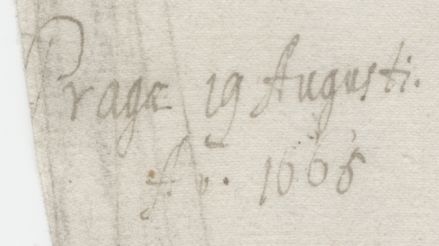
This book, bequeathed to me by an intimate friend, I destined for you, my very dear Athanasius, as soon as it came into my possession,
[...]
The former owner of this book once asked your opinion by letter, copying and sending you a portion of the book from which he believed you would be able to read the remainder
[...]
To its deciphering he devoted unflagging toil, as is apparent from attempts of his which I send you herewith, and he relinquished hope only with his life.
[...]
Dr. Raphael, tutor in the Bohemian language to Ferdinand III, then King of Bohemia, told me the said book had belonged to the Emperor Rudolph and that he presented the bearer who brought him the book 600 ducats. He believed the author was Roger Bacon, the Englishman. On this point I suspend judgment.
Since the time of Voynich's publication, our knowledge of the history of the MS has increased significantly (4). Many aspects of Voynich's reconstruction of the earlier history of the MS are no longer accepted, and the later history of the MS is much better understood now.
Still, there are important gaps in our knowledge of the history of the MS. Biographical details of the known owners of the MS could be relevant, so their biographies are presented on a separate page.
 |
Biographies of the key people in the history of the MS. |
 |
Portrait gallery of the key people in the history of the MS. |
Following is a schematic overview of the whereabouts of the Voynich MS, according to our present knowledge (5). The small grey blocks indicate the range of uncertainty of the year written above them.

As presented on the previous page, the MS was almost certainly created in the early 15th Century. Its illustrations appear to have both Italian and German characteristics, so perhaps it originates from the wider alpine region, but at the very best the location where the MS was created remains speculation.
Month names have been written near each of the zodiac illustrations in the zodiac section of the MS. These were most probably added some (unknown) time after the creation of the MS. They are written in a Romance language, most probably Northern French (6). This could either indicate that the MS travelled through N. France, or that it was owned at some point in its early history by a native of this area. We have no further evidence about the earliest history of the MS until the very end of the sixteenth century.
The Marci letter clearly suggests that the MS was owned by Rudolf II of Habsburg, who reigned in Prague from 1576 to 1611. This means that there is a gap in our knowledge of at least 150 years. That the MS was in Prague in the early 17th century is certain from the ex libris of Jacobus de Tepenec on the first folio. Tepenec was associated with Rudolf's court from 1608 to 1611. In older literature about the Voynich MS it is usually assumed that the MS was sold to Rudolf by John Dee and/or his associate Edward Kelley, but this assumption is based entirely on a hypothesis of W.Voynich, which he presented in 1921 (see note 1), and which is no longer accepted nowadays. This point is analysed in more detail on a separate page (which also cites all references used).
 |
Did John Dee bring the MS to Prague? |
To summarise, as a result of Voynich's hypothesis, the lives of Dee and Kelley have been scrutinised by many researchers, who found some circumstantial evidence that would confirm this. This evidence has been critically examined by Rafał Prinke, showing that none of it can be substantiated. Also the references by Dee to his mysterious "Book of Soyga" could be verified not to refer to the Voynich MS. The book of Soyga has been found again in two copies by Deborah Harkness, and its mysteries have been resolved by Jim Reeds (7).
The Marci letter indicates that the MS was bought by Rudolf II for the sum of 600 ducats. The reliability of this information is analysed on a separate page.
 |
Did Rudolf really buy the Voynich MS |
If we accept for the moment that Rudolf did indeed buy the MS, it would be of great interest to know from whom he bought it, because this would provide a possible trace further back in time. Voynich mentioned in his 1921 paper that he had investigated the biographies of several hundred of the known visitors to Rudolf's court, and that according to him the most likely candidate was John Dee. Voynich is certainly exaggerating here. From his notes, which are still preserved in the Beinecke library, we know that he picked up about two dozen names from a historical novel set at the court of Rudolf II (8).
 |
Voynich's research of the history of the MS |
In any case, Voynich went on to show how it is possible to trace the path of the MS from 13th Century England and Roger Bacon, through John Dee, to the court of Rudolf II. We have to keep in mind, however, that Voynich was already convinced that the MS originated from Roger Bacon, so he had been looking specifically for a connection to him.
It will be more useful to look for any evidence of such a book sale. Since the Austrian State Archive in Vienna still preserves a large set of summary ledgers which include Rudolf's court accounts (the so-called Hoffinanz), and large parts of these have been transcribed by Austrian researchers (9), I have started to search these transcriptions for any record of Rudolf acquiring books and manuscripts.
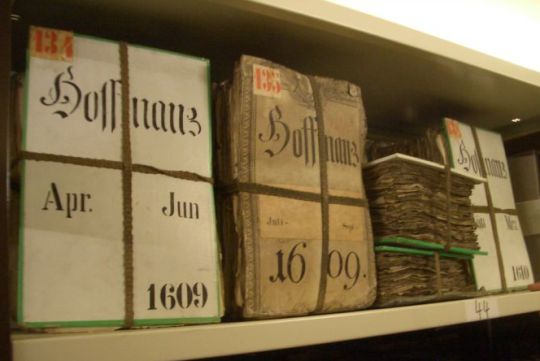
A complication in the interpretation of these accounts is the confusion about the monetary units in Bohemia around this time. The most frequently used coins were the silver Taler (usually worth 70 Kreuzer, but this varied with time), the gold florin (worth 60 Kreuzer), and the gold ducat or Venetian ducat and the crown, both gold coins, generally worth a bit more than a florin, but also with a variable exchange rate.
In the parts available to me no transaction could be identified that definitely referred to the Voynich MS, but there were several cases of some interest, such as:
It is clear from these examples that Rudolf spent very large sums of money on books, also significantly more than the 600 ducats that Marci quotes he paid for the Voynich MS. Since all of the above examples are sales of several books, or a book with some additional items, it is entirely possible that the 600 ducats (if this was indeed the price) was not just for the Voynich MS, but for a set of books including the MS.
Over the years, some additional details could be collected. A large additional set of court records were transcribed and published (printed) in the year books of the Kunsthistorische Museum Wien (12). This greatly increased the number of known book sales, but no other examples of interest for our question emerged. However, a pair of other entries in the original set of online records turned out to refer to the Widemann sale. The most informative one, from 25 February 1600, one year after the sale, says:
Zachariaßen Geizkhoflers schreiben vom 11. dits p. ferttigung aines bevelchs wegen 24 fl., damit sein gegenhandler Mattheß Peugl ain väßl mitt allerlai selzamen büchern, sio zu Augspurg arrestiert gewest, außgelöst und weilandt Hannßen Poppen uberschickht, ligt da ex.
 |
Court finance records |
This is requesting some additional money related to the transfer of a number of books that are described as 'unusual' (selzam), which had been purchased in Augsburg and were sent to Hans Popp, chamberlain of Rudolf II in Prague. It also says that Popp had died in the mean time. This suddenly makes the sale of Widemann's books to Rudolf a lot more interesting.
 |
Biography of Widemann |
Less than a year after finding this second entry, I was contacted by Stefan Guzy, who was interested in pursuing this investigation further. His first step was to visit the family archives of the Geizkoflers in Ludwigsburg, where he was able to find the transaction related to Widemann's books from Augsburg. Here, the price was listed as 600 Rheinische Gulden, that is: 600 gold pieces!! Apart from the florin / ducat confusion, this matches the price quoted in the Marci letter, so we can now be reasonably confident that this is indeed the sale of the Voynich MS, with probably some additional books, to Rudolf.
Guzy's subsequent intensive research uncovered a great deal of additional information of interest. Some of the main details mentioned in his first publication of this work (13) include the location of Widemann's house in Augsburg, which used to belong to the aforementioned Leonhard Rauwolf. This makes Rauwolf a potential candidate as prior owner of the MS, though this has not been confirmed by any evidence. Research in this area is continuing. He also found Widemann's tax records of the time, indicating an increase of his estate by the amount of the sale of these manuscripts. This time, Rudolf seems to have paid up.
If this is indeed the event of the sale of the MS to Rudolf, we know that the bearer of the MS who was mentioned in the Marci letter was Zacharias Geizkofler (14). The sale would have taken place in 1599, and the MS was entrusted to Rudolf's chamberlain Hans Popp, who died soon after this.
.
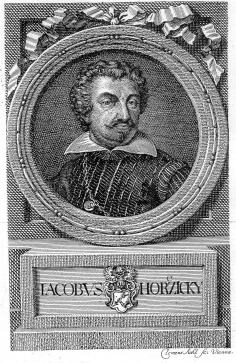
The first positively identified owner of the Voynich MS is Jacobus Horčický de Tepenec. He was born as Jakub Horčický in a poor family, raised by the Jesuits and eventually became a successful and wealthy chemist, and a pharmacist at Rudolf's court. By that time, he used to call himself by his latinised name "Sinapius".
 |
Biography of Jacobus de Tepenec. |
According to tradition, in 1608 he cured Rudolf from a grave disease, and consequently became a favourite of the emperor. This may be apocryphal, but he was certainly raised to a minor nobility in that year, and was allowed to call himself 'de Tepenec'.
He wrote his name in the bottom margin of the first folio of the Voynich MS using the noble form, so he must have done that after 1608. In recent years, several books and manuscripts have been found that include a more or less similar form of his ex libris.
 |
Books once owned by Jacobus de Tepenec. |
In each of these books, his ex libris is accompanied by a number, and such a number is also visible below his name in the Voynich MS. Both name and number have either faded or were erased. They are now only visible under UV illumination. These numbers strongly suggest that there must have been a list or catalogue of his books, but this list has not yet been found. That is a great pity, because his description of the MS might include valuable details about its provenance.
We don't know how or when Horčický obtained the Voynich MS. Many possibilities have been proposed. Perhaps Rudolf gave it to him hoping that he would be able to understand it. Alternatively, when the emperor abdicated in 1611, and died the year after, he still owed Horčický (and many others) a significant amount of money (15). Did Horčický take the law in his own hands and did he take some of Rudolf's possessions with him (including the Voynich MS)? This very dangerous approach was followed by quite a few of his contemporaries with very serious consequences.
Emperor Matthias, Rudolf's successor, eventually presented Horčický with the rule over the community of Melnik, and Horčický lived in its castle as the Hauptmann (governor). When Horčický died, in 1622, he left all his belongings to the Jesuits in Prague and Melnik by testament, but the Voynich MS seems to have escaped from their hands. Several of the books and manuscripts that still bear his ex libris also include an ownership note of the Jesuit college of Prague, but the Voynich MS does not have this (16).
The next known owner of the Voynich MS is the person mentioned by Marci in his 1665 letter to Kircher. Marci wrote that he wanted to send the MS as soon as it came into his possession, as the result of an inheritance from an intimate friend. This friend, who is not named, is further reported to have sent some transcribed portions of the manuscript to Kircher.
John M. Manly suggested that the benefactor of Marci could have been Dionysius Misseroni (17), but his true identity was first suspected by Wilfrid Voynich himself, when he wrote in a letter to Prague (18), that he would like to find out more about the identity of one Georgius Barschius, who, sometime after 1622, left his alchemical library as an inheritance to Marci. Voynich did not include Barschius' name in his 1921 presentation of the history of the Voynich MS, and apparently he never received a reply to the above-mentioned letter. The search for Barschius was briefly taken up by Brumbaugh in the 1970's, but again forgotten after that.
Fortunately, in 1998 I found out from the publications of the historian John Fletcher that one letter from a certain Georg Barsch was preserved in the correspondence of Kircher, which at that time was still essentially unpublished. This collection of letters is already mentioned in the first catalogue of Kircher's museum issued in 1678 (19). This correspondence, originally bound in 12 volumes, disappeared, only to surface again in 1930. From then, until about the year 2000, this collection was only available for study by scholars in a piecemeal fashion (20). The letters are now (bound into fourteen volumes) preserved in the historical archives of the Pontificia Università Gregoriana (APUG). This collection of letters, known as the Carteggio Kircheriano, contains more than 2000 letters from over 750 different correspondents, which include emperors, popes and Jesuit missionaries all over the world. Many letters are from scientists reporting on their discoveries. These letters have been bound together with other material, such as draft letters from Kircher. One of the fourteen volumes of the Kircher correspondence bears a paper attachment saying: 'From the private library of P. Beckx' (21).
In 1998 it turned out to be impossible to obtain access to the few existing microfilm copies of the Kircher correspondence, but when a project was started to digitise and publish it online (22), I was again fortunate that in June 1999 I could obtain a copy of the letter of Barschius from the historians running this project. This single surviving letter from M. Georgius Baresch (23) was written in April 1639, and from this important letter it is clear that Barschius was indeed the owner of the MS. In addition, we learn that a year and a half before that he had sent Kircher a partial transription of the MS, confirming what we had read in the Marci letter of 1665. Barschius also writes that he decided to contact Kircher because of the recent appearance of Kircher's "Prodromus Coptus", and he writes that he believes that the MS was from someone who had travelled the Orient.
We do not know very much about Barschius and he was essentially unknown to Czech historians until recently. Most of what we know stems from the research of Rafał Prinke, and of the Czech historian Josef Smolka.
 |
Biography of Barschius |
He worked as a court relator until 1646. Marci mentions him in his book "Philosophia Vetus Restituta", which appeared in 1662 (24), calling him a very good friend, indicating that they became acquainted 40 years earlier, and that Barschius left Marci his alchemical collection and library in his will. This means that Barschius must have died between 1646 and 1662. Barschius is also mentioned in two letters from Marci to Kircher, written in 1640 and 1641 (25). We do not know how the Voynich MS passed to Barschius, whether Horčický knew Barschius, or if anyone else owned the MS between Horčický and Barschius. Of course, the new discoveries related to the probably sale of the MS from Widemann to Rudolf II allow for some speculation...
 |
Speculation about the unknown history of the MS |
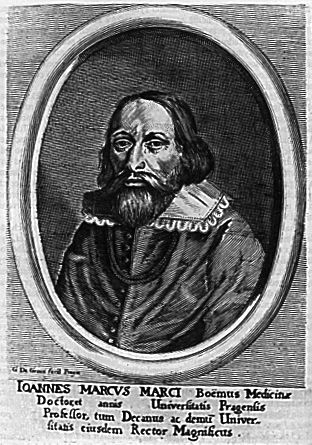
Marci was born in 1595, in the Bohemian town of Landskron. He studied medicine and became professor at the Prague Charles University. Around 1639 he undertook a journey to Rome and there he met Athanasius Kircher. This meeting marked the start of a long friendship and the two men of science corresponded for 25 years. One of the last letters from Marci, written in August 1665, is the one he sent together with the Voynich MS.
 |
Biography of Marci |
We saw above that Marci inherited the Voynich MS from Barschius between 1646 and 1662. He also discussed the MS with Mnišovský before 1644 (the year Mnišovský died), so on that occasion Barschius was still alive and still the owner of the MS. From the wording of the Marci letter it even seems as if this discussion with Mnišovský should have taken place between 1626 and 1636, while Raphael was tutor to Ferdinand III, but this is less certain (26).
Marci wrote to Kircher that he destined the MS for Kircher as soon as he got it, but it is clear that he kept it for a number of years. We have no record of what he did with the MS, or of any personal insight from him. Marci's eyesight deteriorated significantly towards the end of his life. The last two letters from Marci to Kircher are no longer in his own hand but were written by a scribe or a friend, and are both in the same hand. Marci did sign them in his own hand. One of these two is the 'Marci letter', that was sent together with the Voynich MS.
After Marci sent the Voynich MS to Kircher, his friend Godefrid Aloys Kinner (who was also one of Kircher's most prolific correspondents) asked Kircher on two occasions and on Marci's behalf whether Kircher had made any progress in deciphering the book that Marci had sent to him (27). Marci died in April 1667. His last will and testament was drawn up on 31 December 1666, when he had completely lost his eyesight and he was not even capable of writing his own name anymore.
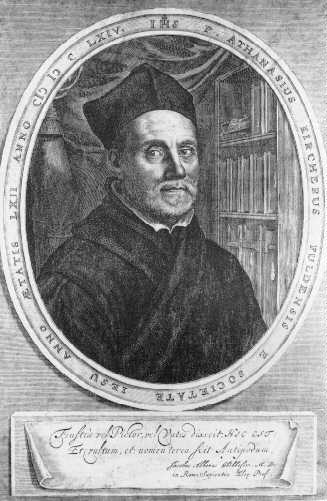
The recipient of the MS, the Jesuit scientist Athanasius Kircher was a contemporary of Marci. He was born in 1601 or 1602 (he himself did not know) in Geisa in Germany and after some adventurous travels he arrived in Rome in 1635, where he would stay, until his death, at the Roman College (Collegium Romanum in the following).
 |
Biography of Athanasius Kircher. |
From 1638 he was professor in mathematics, but his interest covered 'everything under the sun'. Since the early 1630's he published a large number of books, concentrating on a different topic every three to four years. He received visits and letters from scientists, royalty and clergy from all over Europe and also beyond. He also curated the Museo Kircheriano, which became one of the attractions in Rome in the 17th Century, and about which more will be said below.
We don't know much about what Kircher did with the Voynich MS. We do know that he responded to Barschius' first (and now lost) request, which was contained in a letter of 1637 by the Prague jesuit mathematician Theoror Moretus.
 |
Kircher's letter to Moretus. |
Kircher's possible thoughts about the MS are briefly discussed on the next page.
That Kircher received the MS together with the letter from Marci in 1665 is confirmed by the fact that the collection in which the MS was included in 1912 can be traced back to the library of the Collegium Romanum, which also included many other manuscripts of Kircher, as we shall see in the following.
In 1651 a collection of various curious items was donated to the Jesuits, and converted into a small museum that was curated by Athanasius Kircher. Several catalogues of the collection were published. The first one was produced by De Sepi and Kircher and published in 1678 (see note 19). The frontispiece of this catalogue is shown below.
 |
The museum of Athanasius Kircher. |

This catalogue is one of only two sources that gives an insight in the collection of books contained in Kircher's museum. Beside Kircher's own published books it mentions the twelve bound volumes of letters from all over the world, and books in many languages, but not specifically the Voynich MS. It also does not mention several other manuscripts known to have been in Kircher's possession, which are still preserved today.
Later catalogues do not list any of Kircher's books, but a manuscript written shortly after 1700 by Filippo Buonanni, and now preserved in the historical archives of the Gregorian University, mentions a room full of books and manuscripts, also on parchment. Already before 1870 several of Kircher's manuscripts were moved to the Collegium Romanum library (the Bibliotheca Maior). Most probably, the Voynich MS was one of these manuscripts.
The Society of Jesus was suppressed twice, in 1773 and 1873, and experienced more difficult years around 1848. Many of their belongings were confiscated. This part of the history of the Society of Jesus in Rome is highly complicated due to numerous moves of libraries and archives, and a complete study of this is clearly outside the scope of this page. Still, it is important for us as the Voynich MS was caught in the middle of it. I have collected all information I could find about these moves on a dedicated page, and in the following I will summarise the most relevant parts of it.
 |
Supressions of the Society of Jesus in Rome. |
In 1773 the Society of Jesus was suppressed in Rome. Numerous books were removed from the famous library of main college, the Collegium Romanum. The Curia, the central administrative entity of the Society of Jesus, which was based in the Casa Professa, a house directly beside the Gesù church, was sealed off by the Vatican authorities. This also housed the archives of the Society. The Gesù and the Casa Professa (attached to the church) are shown below in a 1756 etching by G.Vasi.
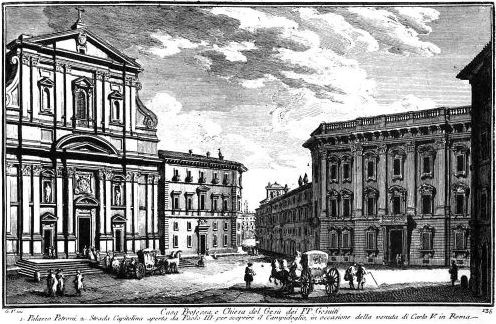
In 1814 the Society of Jesus was officially restored and from 1824 the Jesuits could gradually retrieve their old possessions, including their churches and schools, and the Casa Professa.
Sometime between 1824 and 1870 a large number of manuscripts in the library of the Collegium Romanum were rebound with new covers because the wooden boards that were part of their old covers had been infested by wood worms. It is almost certain that the Voynich MS was one of these rebound manuscripts.
 |
The binding of the Voynich MS. |
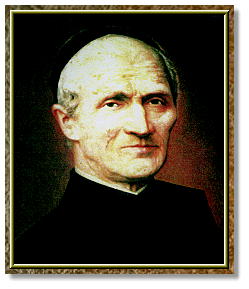 .
.
In 1853, the Belgian father P. Beckx S.J., provincial of Austria, was elected as the new General Superior. In 1855 the Duchess of Sachsen, widow of Francesco Giovanni de Rossi, donated her late husband's extensive and highly valuable private book and MS library to the Jesuits. A very formal donation agreement was signed by P. Beckx. This library was thereafter stored (in boxes) in the Casa Professa, which also housed another major Jesuit library.
 |
The Bibliotheca Rossiana. |
 |
Events in Rome after 1870. |
On 20 September 1870 the troops of Vittorio Emanuele II captured the city of Rome. In June 1873 the law relating to confiscation of Jesuit possessions was extended to the Roman province, taking effect on 20 October. One by one the Jesuit houses in the city were confiscated. The Jesuits had already moved their so-called 'old archives' (i.e. prior to 1824) to the Palazzo Borromeo, a palace then housing the German college, which was not far from the Collegium Romanum. The government had agreed that personal belongings of the Jesuit fathers could be kept, while belongings of the society needed to be handed over. The above-mentioned library of the Duchess of Sachsen was protected by the donation contract signed with Beckx, and was eventually shipped to Austria, in accordance with the provisions of this contract.
The main part of the Collegium Romanum library was confiscated on October 20, 1873, and the new government set up the new national library 'Vittorio Emanuele II' in the same building. Kircher's museum was also confiscated, but many of his books and manuscripts had already been moved to the Collegium Romanum library. Some of the items from his museum are presently still preserved in the Museo Etnografico Pigorini in the EUR. Some parts of the original Collegium Romanum library, however, escaped confiscation in various ways.
A personal friend of Fr. Beckx, Don Alessandro of Torlonia, helped the Jesuits by offering them the use of his palace in Castel Gandolfo (the Villa Torlonia), where they could continue the activities of the novitiate of S. Andrea (28). The university activities moved to the above-mentioned German college in Palazzo Borromeo, where it would be known as the Pontificia Università Gregoriana del Collegio Romano. P. Beckx moved to Fiesole, where the new Curia was established, including the modern (i.e. post-1824) section of the archives of the Society.
At least three collections of books and manuscripts from the Biblioteca Maior of the Collegium Romanum were saved from confiscation, or at least for a while. The books and manuscripts of two of these collections were adorned with typewritten labels saying ex Bibliotheca privata P. Petri Beckx.
 |
Collections that escaped from confiscation. |
The first is a collection of approximately 2700 manuscripts, mostly written by Jesuits and including letters and University course materials of Jesuit Professors. This collection is now preserved in the historical archives of the Gregorian University, where it is known as the Fondo APUG. The Kircher correspondence that was already mentioned above is included in this collection. It has been known for some years now, mainly through the work of Lorenzo Mancini, that this collection has been kept at the Villa Torlonia in Castel Gandolfo (29).
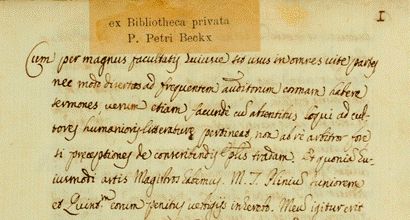
The second is a smaller collection of much older classical and humanist manuscripts, which included the Voynich MS. This collection appears in a handwritten list of manuscripts for sale to the Vatican, and most of these manuscripts are now indeed preserved in the Vatican library (30). For a long time, the whereabouts of this collection were not known with any certainty, and from later accounts (for which see below) this was generally believed to have been the Villa Mondragone in Frascati. However, from the research of Francesca Potenza, working at the Vatican Library, we now know that also this collection, including the Voynich MS, was equally preserved in the Villa Torlonia in Castel Gandolfo (31).
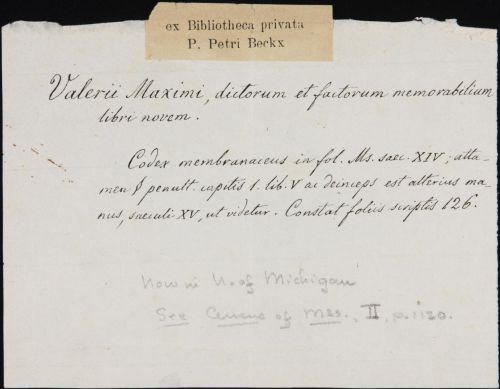
The third collection was hidden in a secret room behind a trap door in the Collegium Romanum building. It became known later as the Ripostiglio. This room was dicovered in 1877, revealing a large collection of Jesuits books and manuscripts. The most important of these (including some Kircher autographs) were moved to the National Library, where they now form the Fondo Gesuitico. Others, considered less important, were stored in an attic of the same building, the so-called soffitta, and subsequently largely ignored. These are now equally preserved in the historical archives of the Gregorian University, known as the Fondo Curia.
Both the first and the thrid of the three collections included manuscripts that used to be owned by Kircher. From remains of shelf marks written on some of these manuscripts and other documentary evidence that has been discovered more recently (see note 31), it is certain that they used to be part of the Bibliotheca Maior of the Collegium Romanum .
Between 1882 and 1885 Henri Hyvernat was teaching theology at the Gregorian University. Almost 50 years later, while working in the US, he was approached by Mrs. Voynich, the widow of Wilfrid Voynich, and she gave him a copy of the Voynich MS. He showed a clear interest, but there is no indication that he had ever seen it before.
In 1884 P. Beckx abdicated and returned to Rome. He died three years later, at the age of 92. One of Beckx's last activities was to assign the task of updating and re-issuing De Backer's bibliography of all Jesuit works to Carlos Sommervogel.
 |
Jesuit bibliography by De Backer and Sommervogel. |
By 1886, Sommervogel temporarily obtained access to some of the hidden archival documents and from this episode we know that the archives were stored somewhere in the Roman province. Sommervogel's work started appearing in 1893, but it does not mention the Carteggio Kircheriano, (already mentioned in De Sepi (1678) (see note 19)), while it does describe many other less significant items of his correspondence. This tells us that this collection was hidden even from the eyes of a Jesuit historian.
In 1892 Luis Martin, the new General of the Society of Jesus and the Curia were still based in Fiesole. There were increasing concerns about further confiscations of Jesuit material by the state, and he decided to secretly move the early archives of the Society from the German college in Rome to Holland. The same ruse was used as in 1873: the items were treated as the private library of the father general. Finally, in 1895, it was considered safe enough for the General and the Curia to return to Rome. Nonetheless, moves of Jesuit archive material continued all the way through the 1920's.
Latest by 1911, the Jesuits decided to sell the above-mentioned collection of classical and humanist books and manuscripts that originated from the library of the Collegium Romanum (the second of the three described here). This was done out of financial needs (see note 31). A summary list of the material for sale is still preserved in the Historical Archives of the Gregorian University (shelf mark APUG 3289), with a photographic copy in the Vatican archives (shelf mark Arch.Bibl.109) (see note 30). The sale, which included the Voynich MS, was completed in July 1912. By this time, the book dealer Wilfrid Voynich had entered the stage.
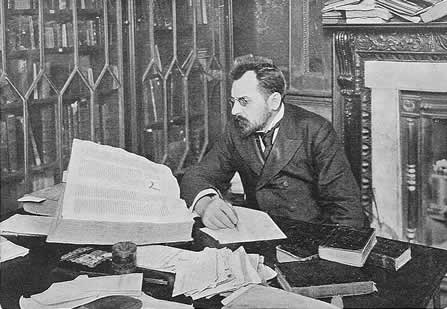
The antiquarian book dealer Wilfrid Voynich was a person with a very colourful past, who entered into the book business in 1898.
 |
Biography of Wilfrid Voynich. |
Initially, he dealt primarily with relatively inexpensive incunabula and other early prints, and he did most of his business with the British Museum. In 1908 he acquired an antiquarian bookstore in Florence. This was previously known as the Libreria Franceschini, named after its previous owner. From 1903 to 1911 the Jesuit father Joseph Strickland, ex alumnus of the nobile collegio Mondragone and still associated with the college, was also working in Florence.
 |
Biography of Joseph Strickland. |
How the two came into contact with each other is not known, but in 1911 or 1912 (32), Voynich obtained the opportunity to acquire a number of valuable manuscripts, upon Fr. Strickland's recommendation and under promise of absolute secrecy about this deal. This was the collection mentioned above, which the Jesuits had dediced to sell. Because of this secrecy, Voynich had to invent a convincing story about the origin of this collection, which included a claim (which he repeated until his death) that he had discovered this collection himself in chests of which the guardians themselves did not know what they contained (33).
The complete collection consisted of approximately 280 manuscripts and some 30 printed books. Many of the books had been labelled as belonging to P. Beckx's private library and they originated from the Jesuit Collegium Romanum library. The majority of these books and manuscripts was acquired by pope Pius X in July 2012 (see note 31), and donated by him to the Vatican library. The 200 Latin manuscripts among these (plus an additional 100 from another collection) are described in a catalogue issued by Mgr. J. Ruysschaert in 1959 (34). Ruysschaert mentions in a footnote in this catalogue that the English book dealer W. Voynich had acquired a number of them, with a tentative list of these manuscripts, including the Voynich MS. The detailed list of manuscripts that Voynich acquired is analysed and tentatively reconstructed on a dedicated page.
 |
List of manuscripts that Voynich acquired from the Jesuits in 1911/1912. |
The new evidence (see note 31) strongly confirms the need for secrecy also in the sale of manuscripts to the Vatican, even though the time of their original hiding is almost 40 years ago. The hiding place of this collection prior to this sale was not recorded by Ruysschaert, and one of his Jesuit advisors for the composition of his catalogue, the historian Miquel Batllori, declared that he has not been able to find any details about this sale of manuscripts to the Vatican library, despite searching for it in the Roman Archives of the Society. We must assume that Ruysschaert did not know. As a result of a statement made by Hans P. Kraus in the early 60's (about whom more later), it has long been generally believed that the collection had been stored in Villa Mondragone in Frascati. However, from the modern research mentioned above, we now know that this is not true, and they were hidden in the Villa Torlonia in Castel Gandolfo.
Also the manuscripts now preserved in the Vatican have bibliographical notes, handwritten on a piece of paper, attached to their inside cover, with an additional type note: Ex Bibliotheca privata P.Petri Beckx glued on top. These are identical to the ones attached to the manuscripts acquired by Voynich that we had already seen above. Voynich had removed these from the manuscripts he obtained, obviously in order to fulfil his promise to the Jesuits not to divulge their origin. With respect to the manuscripts in the Vatican library, the name of Beckx has been scratched out in almost all cases (click on the thumbnail).
Voynich initially kept this collection in Florence (35). He sold seven items to colleague rare book dealer Tammaro De Marinis, who also had his bookstore in Florence. These seven manuscripts are listed in a catalogue of De Marinis issued in 1913 (36), though two of the most valuable items, namely two manuscripts that originated from the famous library of the Hungarian King Mathias Corvinus, were already sold by that time. In fact, we know from Hungarian publications (37) and from a letter preserved in the Morgan library in New York (38) that at least one of these manuscripts was being presented for sale to the Hungarian Archbishop in Budapest, before 26 June 1912, by De Marinis and/or his associate Vittorio Forti. By 29 July 1912 these Corvinates had been sold to John Pierpont Morgan (Sr.) (see note 38).
The sale of manuscripts to the Vatican was initiated on 13 June 1912 and involved an estimate of their value by the Vatican librarian Franz Ehrle, for which he travelled to the Villa Torlonia in Castel Gandolfo on 24 June. This demonstrates that the sale of some of the manuscripts to Voynich was completed before the Vatican library even became involved.
Voynich's main bookstore was still in London, and he took the remaining items of his new valuable collection there, showing them to interested potential buyers (39). At this time, the MS was of course not known as the "Voynich MS", but as the "Roger Bacon cipher MS". Also this MS appears to have been in the hands of another colleague book dealer: Baer from Frankfurt, sometime in or after 1911 (40), but details about this are quite unclear.
When the first World War broke out, Voynich decided to move to the US and expand his business there. Once established in the US, he organised several exhibitions, where he showed some 280 of his most valuable books and manuscripts. This collection included several of the manuscripts he bought from the Jesuits as highlights, in particular also his Roger Bacon cipher MS. After exhibitions in Princeton University and in New York, the most famous exhibition was in October 1915 at the Art Institute of Chicago, which was followed by a short publication (41). Immediately after the Chicago event he had two exhibitions in Michigan (42), and during these events, he explained that he had discovered the manuscripts in a castle in Austria, where they had been hidden, supposedly unknown to the owners of the castle (43). It was only in 1919 that he really became interested in the history of his MS. It is evident from letters and notebooks still preserved in the Beinecke library that from then on Voynich did all he could to find out the truth about it.
 |
Voynich's research of the history of the MS |
Voynich presented his so-called Roger Bacon cipher MS in 1921 at the College of Physicians of Philadelphia, with accompanying presentations, among others from Newbold, which have been published in the proceedings of that event. The paper by Voynich is the presentation that was mentioned at the top of this page (see note 1). Voynich still stuck to his promise not to tell from whom or where he had acquired the manuscripts, and on this occasion he explained that he was keeping the location a secret because he was hoping to return there to buy more books. It is possible that people had already begun to suspect that the manuscripts used to belong to the library of the Collegium Romanum (44), so saying that he had made a secret deal might be more damaging to the Jesuits and/or the Vatican. However, this remains speculation. The only person whom he appears to have told (in confidence) what really happened was his wife.
Voynich died in 1930, and the successive ownership of the MS after his death has recently been clarified, correcting earlier versions of this in several respects (45). The heirs of the MS were his widow Ethel Lilian Voynich, (henceforth ELV, as she preferred to be called), to 60% and his secretary Anne Nill to 40%. About one year later ELV took photostats of the MS to the Catholic University in Washington, to show it to Prof. Henri Hyvernat. Both he and his assistant Theodore Petersen were immediately intrigued by it, but there is no indication that Hyvernat had seen, or even known about the MS before (specifically when he was in Rome). Petersen kept the copy for a while, and made a complete hand transcription of it.
Also in 1930 the new Pontificia Università Gregoriana was opened at its present location in Piazza della Pilotta in Rome. The historical archives of the University received over 2000 Jesuit manuscripts (the first collection mentioned here, i.e. the Fondo APUG, with the typewritten ex libris of P. Beckx).
 |
New Jesuit establishements in Rome. |
This collection had been moved to the Palazzo Borromeo (German college) in 1919. The new Curia was opened in the Borgo, near the Vatican, including the new archives (ARSI). The Jesuit Curia and archive material, previously dispersed over Exaten and Valkenburg in the Netherlands, in the German College in Rome, and in the Italian state archives equally in Rome, were gradually moved to this location. The various moves of Jesuit library items are described in the course of this page and graphical representations of these may be found here.
In 1937 Voynich's London shop was closed, and during the round-up the shopkeeper Herbert Garland discovered the above-mentioned handwritten bibliographical notes with the typewritten attachments: Ex Bibliotheca privata P.Petri Beckx. He sent these to ELV and Anne Nill in the US, who immediately realised that the manuscripts must have originated from the Jesuit college in Rome. Anne M. Nill, Voynich's secretary who was alread mentioned above, had become a close friend of ELV. Upon ELV's death, her share of the ownership of the Voynich MS passed to her unofficial daughter Winnifred Gaye, but Anne Nill remained in charge of its potential sale. Since ELV realised that she was the only one who knew some of the details of the sale of the manuscripts, she wrote a letter, only to be opened after her death, giving the details she remembered (46). Anne Nill opened that letter in 1960, to read that the secret location where Voynich acquired the MS was Frascati, to read about the fact that Voynich had to promise absolute secrecy about this, and about the role of Fr. Strickland.
 |
ELV's letter 'to be opened after her death'. |
However, already in 1937, more than two decades prior to the opening of ELV's letter, the first issue of De Ricci's "Census of Medieval and Renaissance Manuscripts in the United States and Canada" (47) lists that the Voynich MS (as part of "The Estate of Wilfrid M. Voynich") originated from the Collegium Romanum in Rome. This information must have been derived from the paper slips that Herbert Garland had sent to Anne Nill in the same year (see also note 41). As Nill was working for one of the co-authors of the "Census", who was personally interested in the Voynich MS (48), this information could have been added at the last moment.
After the death of ELV, Anne Nill looked for a buyer of the MS. Wilfrid Voynich had stipulated in his will that he wished that a buyer should be an institution rather than a private person, and should be agreed by a committee of 5 persons: his wife, Anne Nill, and three professors he trusted: John Manly, William Warner Bishop and James Westfall Thompson. The sale turned out to be very difficult (see note 45), but in the end a buyer could be found: the famous New York rare book dealer Hans P. Kraus. As desired by Kraus, Anne Nill started sending out letters to all those people who had ever received copies of the MS to please return them, because he wanted to buy only on the condition of exclusive rights to publications about the MS. Evidently, he also had some hope that the MS was of major scientific importance. Some owners of the copies returned these (e.g. Petersen, and the N.Y. Public Library). Most of the others simply responded that they wouldn't make further copies for others, or publish anything about it without first asking the new owner.
Kraus, who decided also to hire Anne Nill as his secretary, bought the MS on 12 July 1961 for $24,500. He initially tried to sell it for $160,000, but he did not succeed. He had promised that a large part of the profit he would make would be given to Anne Nill, but she died only three months later, on 24 September 1961. The MS spent most of this part of its history in a bank vault in New York.
In 1962 Kraus participated in a trip to Italy visiting important libraries and book collections, which was organised by the Grolier Club (49). It was largely facilitated by Tammaro De Marinis, the same person who had acquired some of the Jesuit manuscripts from Voynich in 1912 (50). In a letter to Friedman (and later in his autobiography) Kraus mentions that, while visiting the Vatican library, he talked to the same Mgr. Ruysschaert who had published the catalogue of the Latin manuscripts which the Vatican library acquired in 1912 from the Collegium Romanum. Kraus asked him about the Voynich MS. Ruysschaert apparently thought that the Vatican library owned it, a surprising mistake (51). It was also at this time that he announced that the Voynich MS was found by Voynich in Villa Mondragone. We can only spculate one which basis he made that conclusion, but by now there is no evidence left to support it. (52).
In 1969, Kraus decided to donate the Voynich MS to the Beinecke Rare Book and MS library of Yale University. At the same time, he divided all the collateral material from Voynich's antiquarian business, including catalogues, accounts, notebooks and correspondence into two parts. The part that was apparently related to the Voynich MS (including the Marci letter) was donated to the Beinecke library together with the MS, and it is still kept there today and is available for consultation. The remainder, more related with his (and ELV's) antiquarian business, was donated to the Grolier Club in New York. Both collections have been browsed by many people. Some of the material has been used at this site, but there is still a lot of unexplored material in these collections.
In 1976 a first microfilm copy of the MS was made on the request of Stephen Skinner. Printouts of this microfilm, known as the 'copyflo', could be ordered from the Beinecke library, and were used by many people interested in the MS, over the next few decades. The MS was digitised in colour in 2004 and the result was made freely available on the Beinecke library web site. A second digitisation was made in 2014.
From 10 November 2014 to 26 February 2015 the MS was on public display for the first time since Voynich's lifetime, as part of an >>exhibition at the Folger Shakespeare Library in Washington DC. The detailed list of items that was on display is >>described here. At the occasion of this event it was announced that Yale would publish an affordable photo facsimile of the MS, while in parallel an expensive facsimile edition of the MS would be produced by an expert company. In 2015 this was announced to be the Spanish company Siloé. The photo facsimile was published by Yale University Library in November 2016 (53), and the Siloé facsimile was officially presented to the world on 10 November 2017, during a festive press event in Burgos (54).
I am grateful to the Beinecke Rare Book and MS Library of Yale University for access to their material, and to APUG (Rome, Historical Archives of the Pontifical Gregorian University/ Roma, Archivio storico della Pontificia Universit Gregoriana) for helpful information about the history of Jesuit library and archive material.
In addition, valuable contributions were gratefully received from the following persons, in alphabetical order:
Claudio Antonini (USA),
Monica Blanchard (Catholic Univ. of America),
Marcela Budíková (Brno, Chech Republic),
Stefano Casotto (Univ. of Padova),
Xavier Ceccaldi (USA),
Noel Golvers (Leuven, Belgium),
Michael John Gorman (Stanford Univ, USA),
Stefan Guzy (Berlin, Germany),
Jan Bedrich Hurych (Ontario, Canada),
Gabriel Landini (Birmingham Univ., UK),
Lorenzo Mancini (formerly at the Historical archives of the Gregorian University),
Joseph McDonnell S.J. (Fairfield Univ),
Philip Neal (UK),
Rafał Prinke (Poznan, Poland),
Jim Reeds (USA),
Rich SantaColoma (USA),
Michelle Smith (Frascati),
Josef Smolka (Prague),
Manfred Staudinger (Vienna),
Jorge Stolfi (University of Campinas, Brazil),
Ellie Velinska (USA),
Felix Villarreal S.J. (Sogang Univ., S.Korea).
They have been reflected either on this page, the page about the origin of the Voynich MS, or the biographies page.
 |
 |
 |
 |
 |
 |
 |
 |
 |
 |